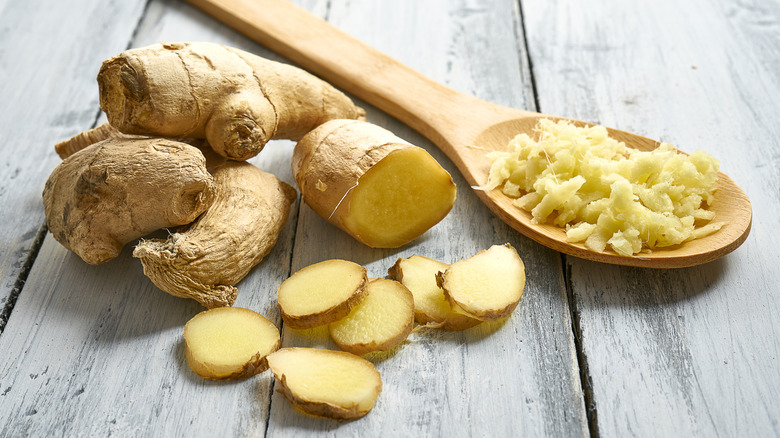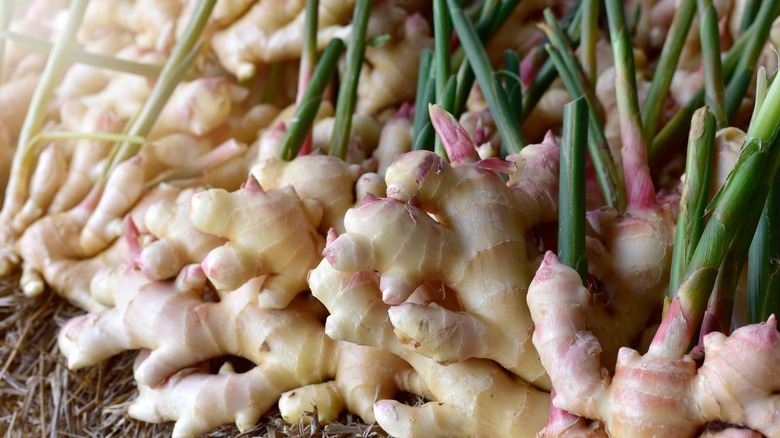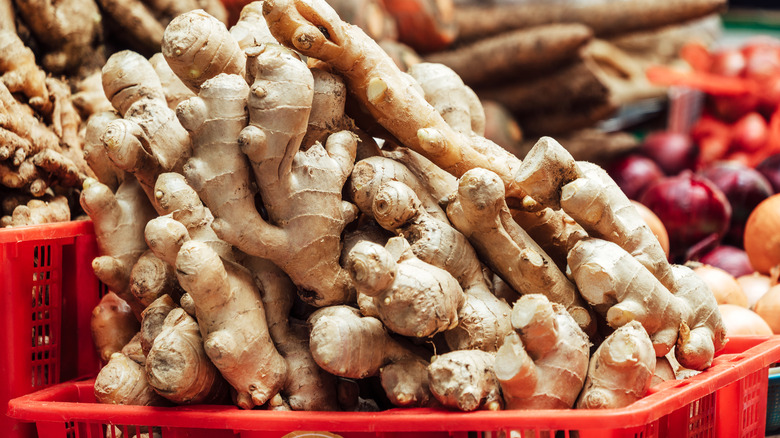Young Ginger Vs Mature: What's The Difference?
Earthy, lemony, with a burst of warmth that's peppery — ginger's complex yet pleasant flavor is a welcome addition to many dishes, making it a staple in Southeast Asian and Indian cuisines. While using its powdered version can be useful, especially in baking, having fresh ginger in the kitchen is optimal for enjoying its aromatic, flavorful, and medicinal benefits in their full potency.
To give your dishes the exact gingery punch they need, knowing the respective qualities of this spice's variants is key. You might not think much about switching one for the other, but there are crucial distinctions between a young ginger and a mature one. These differences are not only visually observable but they also affect the flavor they impart to your cooking. Once you've seen and tasted the particular nuances of each one, you'll be more mindful about buying and using the right type for your specific culinary purpose.
Young ginger has pale, thin skin and a subtle flavor
Since they're harvested only eight months after getting planted, young ginger feels smoother and more tender to the touch than mature ginger, which is usually harvested after a year. It has a light cream hue that turns pink around the areas where there are still small green shoots attached. Due to its soft, nearly translucent skin that rubs off easily, you don't really need to peel young ginger.
Because it hasn't matured yet, the flavor of this ginger variety is mild and delicate with an almost floral sweetness. This makes it perfect for dishes where you want only a hint of that ginger heat and taste to enhance the other flavors of a dish. Infuse your tea with slices of young ginger if you want a warm yet soothing drink. Dice or grate it to make a lightly spiced syrup for cocktail drinks. Young ginger also goes well with stir-fry and salads since it won't overwhelm the medley of tastes from the other ingredients. Thanks to its delicate yet juicy texture, it's great for pickling, either on its own or with other vegetables. Pickled young ginger is a refreshing side dish that accompanies a variety of Asian dishes, most popularly Japanese sushi where it's referred to as gari.
Because young ginger is perishable and won't survive long transports and storage, you'll find US-grown ones more in farmers' markets than in supermarkets. Its harvest season runs from mid-September to early November.
Mature ginger feels firmer and has a more robust flavor
Ginger reveals its maturity with its skin: thicker, firmer, with a slightly wrinkled texture and a darker color. Its flesh is also more fibrous. Because it has fully developed, mature ginger has a stronger, more robust taste and aroma and its depth of flavor comes with a slightly woody zing. It's the best choice when you want your soups, stews, and curries to have a more ginger-forward flavor profile. It's also great for adding a potent yet pleasant heat to your stir-fry and for making your marinades, salad dressing, and pickles more pungent and flavorful.
As the most common variety used in cooking, mature ginger is more readily available and easier to store than young ginger. Keep it in a cool, dark place so it stays fresh for a few days. Otherwise, place it in the crisper drawer of your fridge in an air-tight container where it can last for two to three weeks when peeled and longer when unpeeled.
Buying freshly harvested mature ginger is key to getting this spice variant's premium flavor. A simple hack for picking it out involves scratching its skin with a fingernail to see if it easily peels off. If it proves hard to remove, the produce may have been in stock for a while. You can also break off a small part from a much bigger piece. The ginger is fresh if it snaps off easily and cleanly.


